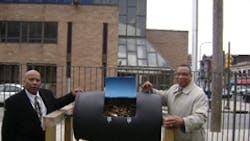GCA Higher Education Grand Award: Temple University Health Sciences Center, Philadelphia
GCA Higher Education Grand Award
Temple University Health Sciences Center, Philadelphia, Pennsylvania
PROGRAM INFORMATION
Number of students: 3,068
Square footage maintained: 1.2 million
Number of full-time custodians: 39
Annual cleaning budget: $2.5 million
Green cleaning team members: Robert McCabe, Senior Facilities Manager @ Temple HSC; Allen E. Rudd, CHESP, I.C.E., Head Custodian; Kathleen Grady, AICP, LEED AP, Sustainability Coordinator Temple University; Michael Ross, I.C.E., Assistant Custodial Director; ARAMARK Higher Education (Facilities), Cleaning Contractor; Ecolab, Eastern Bag & Paper, Grainger, Tennant, Orbio, Mac Medical, Janitorial Product Distributors; GEMA (Germantown Erie Merchants Association) in partnership with Temple University HSC community support program, Zion Baptist Church, Community Groups
Temple University HSC started a contract with Aramark Higher Education (Facilities) in July 2007. Temple had a good recycling program that was created in 1989, and Aramark worked with Temple to enhance the program. As a result of this collaboration, Temple has a standardized program and has also won several RecyclelMania Awards.
The company also has partnered with Temple HSC to join its Sustainability Committee to support several initiatives such as the Medical School Sustainable Garden, The Sustainability Pledge, Sustainable Moves Policy and the University President Climate Action for Plan Waste Minimization, Recycling, etc. with very positive results.
The ultimate in environmentally friendly cleaning and surpassing traditional green cleaning thinking, blue cleaning program is Temple’s innovative custodial approach that is scientifically proven to support health and wellness and environmental stewardship.
Starting in 2011, Temple launched a blue cleaning program that goes beyond green by eliminating chemicals and using Electrically Activated Water (EAW) and or other non-chemical sources to create the most environmentally responsible approach to cleaning.
Rather than using chemicals when applicable, blue cleaning is a tap water-based approach to cleaning. By activating water with electricity, blue cleaning is able to clean and create a positive charge that attracts dirt.
The blue cleaning program supports improvement in indoor air quality, waste stream management and carbon- footprint reduction. There are three elements of a blue cleaning program; Technology, Training and Touch.
In the Technology element, multiple blue cleaning technologies are used for cleaning. The blue cleaning program has many proven technologies available such as self-generated EAW, ionized water, microfiber, stone floor care and matting to allow for replacement of traditional chemicals with technologies.
The Training element requires a thoughtful approach for employees with both hands-on and classroom training to understand applicable technologies and how to align within the blue cleaning program to ensure equipment is being used properly and in approved areas .
There is a greater to need to “Touch” our faculty, staff and students by communicating a blue cleaning program and engaging in organizations and or activities with our facilities communities.
The university launched another technology of self-generating EAW with a solution for cleaning, sanitizing and disinfectant in October, which will allow the program to remove additional harmful chemicals.
This campus has a lot of clinical space that has to be serviced by staff and uses an EPA-approved disinfectant. A very aggressive training program is conducted during departmental orientation as well as ongoing follow-up training. Most of the time, the re-training is a result of the university’s QA Inspection Process and the results of a quality review.
Aramark has partnered with the Temple University Hospital Infection Control Practitioner to improve the Handwashing Program for the clinical staff and the environment. The waterless hand sanitizer and hand lotion were an upgrade for the Temple Clinical Space environment and enables the community, employees and the staff to maintain good handwashing practices. Aramark has a Safety Program in its Safety Portal that enables it to continuously train and re-train on an annual calendar, and it is mandatory for all employees, including the management team. There is also a mandatory Safety Training Program that is conducted annually by the Temple Environmental Health & Radiation Safety Team that is designed specifically for the Aramark employees. This program gives specific information on how to clean the lab space and apply cleaning procedures to the Temple research lab environment. (There’s also an extensive program for waste management and disposal practices).
Entrance mats are vacuumed several times daily to prevent the dirt from getting in the facilities, especially in high-traffic areas. The carpets in the buildings are monitored daily for the spotting service, cleanliness and debris as part of a routine cleaning process. The structure that Temple uses to clean is the 7 Step Cleaning Process, and the floor and carpet program uses a 4 Step Cleaning Process. These processes are uniform, so the QA Inspection Program is designed to measure the results of these cleaning processes maintained by our team and ensure that the cleanliness meets the specified APPA Level. The inspections are done daily and the results are recorded and presented quarterly.
Training is provided through the ARAMARK College of Facilities Management. The School of Custodial Services classes are held on a center of excellence college campus, providing a five-day training course on the Quantum Leap blue cleaning program. The training encompasses standard operating procedures of the program, manual design, mobile custodian inspections, Custodial Industry Management Systems (CIMs), space care, floor care, carpet care, marble/terrazzo care, touchless cleaning, organizational design and how to go from green to blue.
